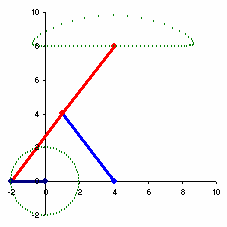3-Position Synthesis with Inversion Method using Unigraphics NX4 Sketch - Part 2
In previous posts, the fixed pivot points were determined from the moving pivot points. We can get result that can't be fitted in our design due to space limit. The principle of inversion can be applied to solve this problem. The first step is to find the three positions of the ground plan that correspond to the three desired coupler positions.
We start with our desired positions of fixed pivot points.
1) Draw desired fixed pivots (O2 and O4) and moving pivot points. Red lines are three desired positions of links (moving pivots).
2) Draw lines to make fixed relations between the ground plane (O2O4) and the second coupler position.
3) Transfer the ground position to the first coupler position using same relations developed in previous step as shown in dashed lines. Name new ground positions as O'2 and O'4 respectively.
4) Draw lines to make fixed relations between the ground plane (O2O4) and the third coupler position (A3B3).
5) Transfer the ground position to the first coupler position using same relations developed in previous step as shown in dashed lines. Name new ground positions as O''2 and O''4 respectively.
6) Draw lines O2O'2 and O'2O''2, bisect both lines and extend the perpendicular bisectors until they intersect. Label the intersection G.
6) Draw lines O4O'4 and O'4O''4, bisect both lines and extend the perpendicular bisectors until they intersect. Label the intersection H.
7) Draw O2G, GH and O4H. Now we get G and H as inverted fixed pivot points of moving link O2O4.
8) Re-invert the linkage to return to the original arrangement.
Let's see how it moves in [3-Position Synthesis with Inversion Method using Unigraphics NX4 Sketch - Part 3]
Further reading:
We start with our desired positions of fixed pivot points.
1) Draw desired fixed pivots (O2 and O4) and moving pivot points. Red lines are three desired positions of links (moving pivots).
2) Draw lines to make fixed relations between the ground plane (O2O4) and the second coupler position.
3) Transfer the ground position to the first coupler position using same relations developed in previous step as shown in dashed lines. Name new ground positions as O'2 and O'4 respectively.
4) Draw lines to make fixed relations between the ground plane (O2O4) and the third coupler position (A3B3).
5) Transfer the ground position to the first coupler position using same relations developed in previous step as shown in dashed lines. Name new ground positions as O''2 and O''4 respectively.
6) Draw lines O2O'2 and O'2O''2, bisect both lines and extend the perpendicular bisectors until they intersect. Label the intersection G.
6) Draw lines O4O'4 and O'4O''4, bisect both lines and extend the perpendicular bisectors until they intersect. Label the intersection H.
7) Draw O2G, GH and O4H. Now we get G and H as inverted fixed pivot points of moving link O2O4.
8) Re-invert the linkage to return to the original arrangement.
Let's see how it moves in [3-Position Synthesis with Inversion Method using Unigraphics NX4 Sketch - Part 3]
Further reading:













Comments